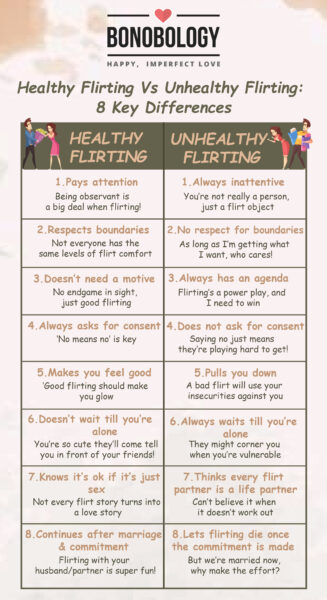There are so many questions about flirting. What are healthy flirting and unhealthy flirting? Are there different types of flirting? What are some healthy flirting lines one shouldn’t cross? It’s enough to make you want to retire to bed with a soothing hot water bottle and vow never to attempt to flirt again! Well, don’t retire just yet. We think flirting is an art and a science, but the joy of flirting really lies in knowing how to conduct yourself in a healthy, confident manner while not coming off as a creep. It’s also about having fun and making the other person feel good about themselves. We give you some key differences between healthy flirting and unhealthy flirting that will hopefully have you hopping back, or taking a cautious first step, onto the flirting bandwagon.
What Is Healthy Flirting?
First and foremost we need to understand what is healthy flirting. We have often heard that flirting is good for health but how do you it is healthy for both parties? Healthy flirting means respecting boundaries and ensuring that you are not offending the other person. It is supposed to be fun and casual. It doesn’t necessarily mean that you both are interested in each other. Since it is a fun activity, people can casually flirt as long as there is consent and no lines are being crossed.
What Is Unhealthy Flirting?
Before we get into the key differences between healthy flirting and unhealthy flirting, let’s be clear about what constitutes completely unhealthy flirting i.e. the absolute non-negotiables in the Land of Flirting. Unhealthy flirting constitutes a lack of respect for boundaries and cares nothing for consent or the other person’s comfort levels. Remember, everyone has their own comfort zones of conversation and intimacy that make them feel good, and healthy and harmless flirting demands that you recognize this and flirt accordingly. In a nutshell, someone who is into unhealthy flirting is utterly selfish because their only motive while flirting is to ensure that they have a good time, even if the other person’s not really into it. Or they’re simply scratching a flirty itch without putting much thought into it. If we’ve thoroughly depressed and unnerved you with all this talk of unhealthy flirting, never fear. It’s time to look at some of the factors that are integral to healthy flirting, and how it differs from tired, creepy, and the cringiest pick-up lines that don’t work on anyone.
8 Key Differences Between Healthy Flirting And Unhealthy Flirting
All right! Let’s put our flirting caps on. We’ve focused on unhealthy flirting quite a bit, so hopefully, you know a little about what not to do when trying to flirt. Now, let’s delve into some healthy flirting tips and focus on the key differences between healthy and unhealthy flirting:
1. Healthy flirting pays attention, unhealthy flirting does not
Imagine you’re at a party and you see an attractive stranger eyeing you. Or you’re on the subway, reading, and you can feel a fellow passenger looking at you. When they approach you, will they say something thoughtful like, “Is that a good book? I’m looking for something to read?” or simply go, “A beautiful woman like you shouldn’t be standing alone?” The difference here is that in the first case, they’ve noticed what you’re doing and tried to strike up a conversation over simply making a statement about your looks and a judgment about women being alone. Part of the joy of flirting is to pay attention to little things about the other person, and know that, in turn, they’re paying attention to you. Even if you’ve just met, someone who’s into healthy flirting will notice if your glass is empty or if there’s a subway route you frequent (in a non-stalker way!) and so on. Attention is the food of love (with many apologies to Shakespeare) and it’s certainly the main course where flirting is concerned. An unhealthy flirt, on the other hand, will take refuge in clichés and clumsily attempt to get your attention, without actually paying attention to you. Paying attention in a relationship is paramount, and the same holds for flirting.
2. Healthy flirting respects boundaries, unhealthy flirting takes what it wants
We’ve already outlined that unhealthy flirting is all about the person doing the flirting with no thought or concern for the person at the receiving end. In healthy flirting, however, boundaries are recognized, acknowledged, and respected. “I like the attention when someone approaches me and shows interest,” says Paula. “But, I’m not comfortable with explicit sexual innuendo or physical touch unless we’ve gotten to know each other at least a little. Even if we’ve been talking for a few weeks, I’d like a little more time before we get to that stage, if at all.” Paula adds that there have been those who flirted and assumed that she was ready for more, even though she wasn’t. They couldn’t understand how she was willing to respond to the conversation but switched off if it crossed a certain line. There are those who flirt simply for the thrill of it, and there are also those who seek comfort and familiarity before getting intimate, even if it’s verbal intimacy. Healthy flirting is all about realizing that we’re all looking for different things when we flirt or respond to a flirtatious overture. Like healthy relationship boundaries, flirting, too, needs respect and consideration.
3. Healthy flirting knows it doesn’t need a motive or goal
Frankly, my favorite thing about flirting is that it doesn’t necessarily need to end with a hook-up at the end of the night or grow into a full-blown love affair. It can, of course, and how great is it if a good love story starts with a great flirty account? But, healthy flirting can be its own reward. The joy of flirting comes alive when the pressure is off to make a ‘conquest’ or prove a point. Maybe you’ve gotten all dressed up, squeezed into your favorite red dress and perilously high heels, and headed to a nightclub. Someone cute approaches, and you get to talking and buy each other a few drinks. There’s a magnetic attraction, and the conversation is great, but by the end of the night, by mutual agreement, there’s no next step. Maybe you exchange numbers, maybe you don’t. None of this means your night was a bust. Healthy flirting doesn’t come with an agenda. It could also be that a good bout of flirting leads to a great one-night stand and no more. That’s amazing too. That’s the great thing about good flirting – you win either way.
4. Healthy flirting takes consent into account
“I get really annoyed when I’ve said ‘no, not interested’ and they keep coming back,” says Austin. “It’s like they assume I don’t know my own mind or that I’m just playing hard to get. It’s creepy and definitely won’t make my list of healthy flirting examples.” For Austin and many others, harmless flirting is when you’re not making it a power play. The minute you refuse to take consent as a cornerstone of healthy flirting, you’ve crossed over into the Creep Zone. Consent in dating, consent in relationships, consent in marriage – we’re all aware of these. Consent is needed at every step of communication, romantic or otherwise, so why should flirting be any different? Persistence might be sexy in Victorian romance novels, and even those are becoming more enlightened these days. But assuming that keeping your flirt game going when someone’s obviously not interested, doesn’t make you sexier, it just means you’re harassing them. And whether you’re thinking of the different types of flirting, or wondering what is bad flirting, ‘harassment’ is not a word we associate with anything healthy. ‘No means no’ is one of the most important healthy flirting lines to remember. Write it down, make a note on your phone, and tattoo it on your wrist if you think it’s needed. You’ve made your move and they’re not interested, it’s time to move on.
5. Healthy flirting makes you feel good about yourself
What is bad flirting? Someone who tries to cut you down and uses your insecurities against you to make you say yes to them. Of all the types of flirting, this is probably the worst and definitely doesn’t make our list of healthy flirting tips. “Let’s face it, we all like compliments,” says Marian. “As women, especially, we’re forever being told we need to be thinner, lighter, prettier, and so on. If someone’s flirting with me, but they’re pulling me down, making me feel unattractive like they’re doing me a favor by giving me attention – well, that’s not sexy.” Marian also emphasizes that while compliments are great, they need to be sincere. “Even if we’ve just met, and all you’re saying is that I’m really pretty, it would be nice to know you mean it and your eyes aren’t skittering over the room looking for the next conquest in case I say no.” Healthy flirting usually needs to be more than just a line. Or if it is a line, make it uplifting and sincere rather than making someone feel bad about themselves. As a healthy flirt, you need to be at least partially secure yourself so you can spread that sweet, sweet flirt energy in the best possible way.
6. Healthy flirting doesn’t wait till you’re alone
Ryan Gosling fans, remember that scene in the (deeply weird) movie Crazy Stupid Love where Gosling approaches Emma Stone for the first time? She’s with a friend but he comes up to her anyway and tells her she’s super cute. Now, not all of us have a Ryan Gosling level of confidence, or his abs. Also, maybe you’re thinking it’s horribly rude to come up and interrupt a conversation because you find someone in a group attractive. But, in the name of healthy flirting examples, hear me out. As a woman who likes doing things on my own, I’ve had plenty of people come up to me when I’m alone, and it’s terribly obvious that they’re approaching because I’m alone, and therefore, an easy target and more vulnerable. My reaction in such cases is always to stiffen up and question their intentions. It’s also the inherent assumption that a woman alone is either single and/or desperate for attention and thus will say yes to you no matter what. I could be happily single and simply out on my own – who’s going to consider that? But a couple of times, I’ve been out in a group, and someone has politely come up and expressed interest. And I’ve really appreciated it because they didn’t wait until I was alone and because it takes more courage to approach someone when they’re surrounded by people. Also, it’s kind of hot that someone thinks you’re so cute they can’t wait to tell you!
7. Healthy flirting knows that ‘just sex’ is just fine
Hello, this is your reminder that healthy flirting will not always lead to a long-term love affair or a starry-eyed romance. Sometimes, it’ll be one great night or a series of great nights or casual dating or friends with benefits. And they’re all perfectly valid, perfectly healthy ways of loving and lusting. “I’d just gone through a breakup, and I wasn’t looking for anything serious or long-term,” says Meg. “I wanted attention, I wanted someone to make me feel sexy, and I wanted to be touched and held without worrying about any strings or what might happen the next morning or if they would call or text.” Meg adds that a few of the men she got together with couldn’t believe that she didn’t want anything more. “They didn’t know when to back off, couldn’t see that a little harmless flirting and intimacy was good for me. A couple of them kept texting and accusing me of leading them on, though I’d been clear about my intentions.” We love a happily-ever-after kind of love story but we also love a great night of good sex and fun. Healthy flirting focuses on what’s good for all parties concerned. If you’re looking for your forever love, that’s great, but remember we’re all searching for love on our own terms, and that’s fine.
8. Healthy flirting doesn’t stop after marriage/commitment
Flirting is so often seen as exclusive to singletons and those looking for a little spice in their single lives. But healthy flirting is a wonderful way to keep the spark alive in a marriage or long-term relationship, especially if you’re in a long-distance relationship. Now, we mean flirting with your own spouse or partner, not someone else’s. If a married man is flirting with you, or your husband is flirting with another woman, that’s unhealthy flirting, a whole other story and your relationship probably need professional help. If this is the case, feel free to reach out to Bonobology’s panel of counselors. Once your love story has completed a few years, it’s easy to forget the things you did to show how much you fancy each other. How to romantically flirt with your spouse isn’t something that’s often talked about often but it’s lovely to be able to flirt with someone you already know is yours. Flirty texts, telling your partner that a new pair of pants looks great on them, and kissing them for no reason are all great signs of healthy flirting. In fact, it’s unhealthy to let your relationship languish because you can’t be bothered to flirt anymore!
5 Examples Of Healthy Flirting
Now that you are aware of what is the difference between healthy and unhealthy flirting, here are 5 examples of healthy flirting to help you up your game:
I have a secret to tell you, but I want to tell you in personYou’re single. I’m single. I feel like this is a problem we can solve togetherIt’s cold today. Can I warm you up?I can’t focus today. I’m too distracted thinking about youAre you a triangle? Because you’re acute
There’s a lot to be said for healthy flirting and for flexing your flirt muscles as often as possible, whether it’s with your established partner or someone brand new, or a crush you’ve had feelings for forever. In fact, like most skills, flirting needs practice if it’s going to become a healthy source of joy and fun. Flirting is a delicate balance – that’s why it’s so important to know the difference between healthy and unhealthy advances. Before taking any steps to flirt, stop and have a good think about what is bad flirting, what it entails, and how close it can come to harassment. This article has been updated in October, 2022



